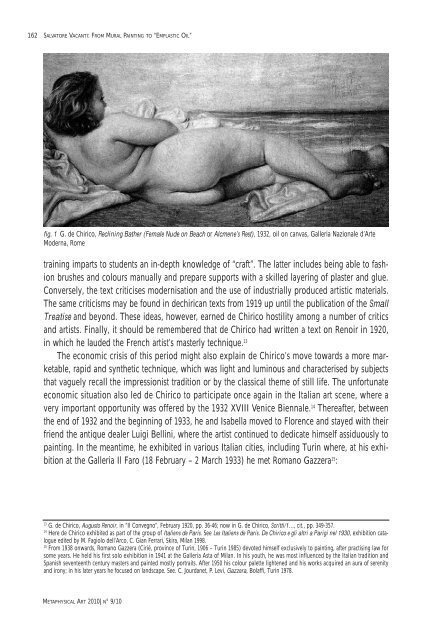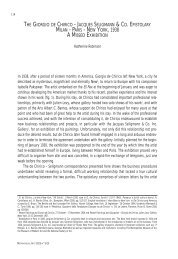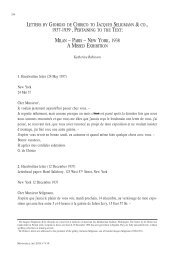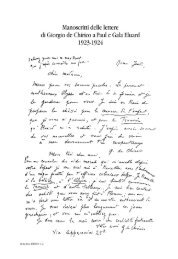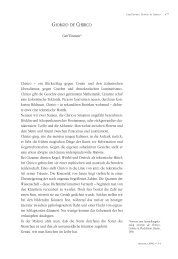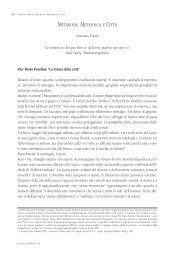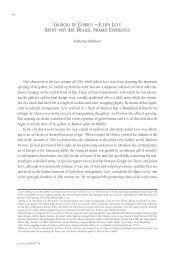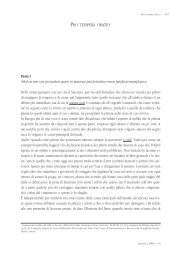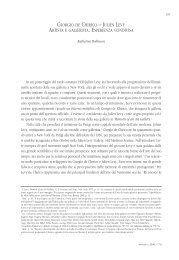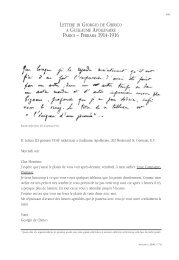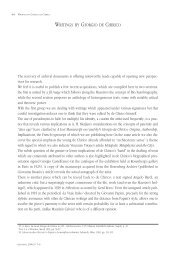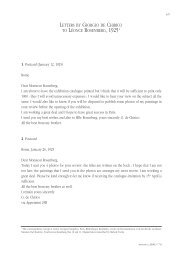Emplastic Oil - Fondazione Giorgio e Isa de Chirico
Emplastic Oil - Fondazione Giorgio e Isa de Chirico
Emplastic Oil - Fondazione Giorgio e Isa de Chirico
You also want an ePaper? Increase the reach of your titles
YUMPU automatically turns print PDFs into web optimized ePapers that Google loves.
162<br />
SALVATORE VACANTI: FROM MURAL PAINTING TO “EMPLASTIC OIL”<br />
fig. 1 G. <strong>de</strong> <strong>Chirico</strong>, Reclining Bather (Female Nu<strong>de</strong> on Beach or Alcmene’s Rest), 1932, oil on canvas, Galleria Nazionale d’Arte<br />
Mo<strong>de</strong>rna, Rome<br />
training imparts to stu<strong>de</strong>nts an in-<strong>de</strong>pth knowledge of “craft”. The latter inclu<strong>de</strong>s being able to fashion<br />
brushes and colours manually and prepare supports with a skilled layering of plaster and glue.<br />
Conversely, the text criticises mo<strong>de</strong>rnisation and the use of industrially produced artistic materials.<br />
The same criticisms may be found in <strong>de</strong>chirican texts from 1919 up until the publication of the Small<br />
Treatise and beyond. These i<strong>de</strong>as, however, earned <strong>de</strong> <strong>Chirico</strong> hostility among a number of critics<br />
and artists. Finally, it should be remembered that <strong>de</strong> <strong>Chirico</strong> had written a text on Renoir in 1920,<br />
in which he lau<strong>de</strong>d the French artist’s masterly technique. 13<br />
The economic crisis of this period might also explain <strong>de</strong> <strong>Chirico</strong>’s move towards a more marketable,<br />
rapid and synthetic technique, which was light and luminous and characterised by subjects<br />
that vaguely recall the impressionist tradition or by the classical theme of still life. The unfortunate<br />
economic situation also led <strong>de</strong> <strong>Chirico</strong> to participate once again in the Italian art scene, where a<br />
very important opportunity was offered by the 1932 XVIII Venice Biennale. 14 Thereafter, between<br />
the end of 1932 and the beginning of 1933, he and <strong>Isa</strong>bella moved to Florence and stayed with their<br />
friend the antique <strong>de</strong>aler Luigi Bellini, where the artist continued to <strong>de</strong>dicate himself assiduously to<br />
painting. In the meantime, he exhibited in various Italian cities, including Turin where, at his exhibition<br />
at the Galleria Il Faro (18 February – 2 March 1933) he met Romano Gazzera 15 :<br />
13<br />
G. <strong>de</strong> <strong>Chirico</strong>, Augusto Renoir, in “Il Convegno”, February 1920, pp. 36-46; now in G. <strong>de</strong> <strong>Chirico</strong>, Scritti/1…, cit., pp. 349-357.<br />
14<br />
Here <strong>de</strong> <strong>Chirico</strong> exhibited as part of the group of Italiens <strong>de</strong> Paris. See Les Italiens <strong>de</strong> Paris. De <strong>Chirico</strong> e gli altri a Parigi nel 1930, exhibition catalogue<br />
edited by M. Fagiolo <strong>de</strong>ll’Arco, C. Gian Ferrari, Skira, Milan 1998.<br />
15<br />
From 1938 onwards, Romano Gazzera (Ciriè, province of Turin, 1906 – Turin 1985) <strong>de</strong>voted himself exclusively to painting, after practising law for<br />
some years. He held his first solo exhibition in 1941 at the Galleria Asta of Milan. In his youth, he was most influenced by the Italian tradition and<br />
Spanish seventeenth century masters and painted mostly portraits. After 1950 his colour palette lightened and his works acquired an aura of serenity<br />
and irony; in his later years he focused on landscape. See. C. Jourdanet, P. Levi, Gazzera, Bolaffi, Turin 1978.<br />
METAPHYSICAL ART 2010|N° 9/10


